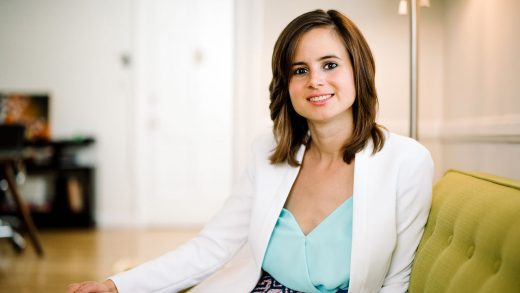How To Get A Match, According to Tinder’s Sociologist
Like so many things in life, romance and sexuality are being rewired by apps. Since 2013, the use of Internet dating services like Tinder and OKCupid has tripled among Americans ages 18-24, according to the Pew Research Center.
It’s a seismic shift, but what does it mean for society? Most online daters think it’s a great way to meet people, and a growing number of marriages stem from relationships that started online. But dating apps can lead to uncomfortable encounters, especially for women. To help understand the social impact of online dating—and feed that intelligence back into its popular app—Tinder employs a sociologist named Jessica Carbino. We talked to Carbino about her job, the research she conducts, and what Tinder users can learn from science to find better matches.
Why does Tinder need a sociologist on staff?
A company like Tinder needs a sociologist because we’re trying to understand what individuals desire and how they behave. A sociological lens to understand a user’s dating history is pretty logical. Individuals don’t operate in a bubble and they are quite affected by the institutions in which they’re operating. Tinder and online dating generally are two of those institutions. The options that we have regarding the individuals that we date are largely structured by the communities that we’re embedded in and the individuals with whom we regularly have contact. Tinder provides people with a way to have a larger degree of contact.
What’s your day-to-day job like?
My job is to understand user behavior and then use that understanding to create a better experience for users. I employ several methodological approaches that I was trained in while doing my doctorate at UCLA to understand user behavior ranging from surveys, focus groups, content analysis. All of these methods provide me with a different perspective of how the product should be oriented toward our users. Day to day, my job is pretty variable. I’m inspecting surveys. I’m analyzing data related to our users’ preferences. Evaluating prospective features. The common thread throughout my day-to-day is that I’m trying to understand how best to improve the Tinder user experience.
Tell me more about the user research Tinder does. Can you give me some examples?
A big project that was done about six months ago was one where I analyzed about 12,000 photos of users throughout the country—New York, Los Angeles, Atlanta—and I analyzed their photos to understand how the users presented themselves. There were 141 variables that were analyzed over the course of those photographs. Were they tilting their heads in a certain direction? Did they have a selfie? What were they wearing? What was the color of their clothing? Who was in the picture with them? Was it parents? Somebody of the other gender? Did they have a dog? A cat? A tiger? All of those things were part of the analysis and can help you understand how people present themselves.
What kinds of things can you learn from that? And how might that translate back into the product?
A lot of our users tell us that they don’t understand how to present themselves and that they want to improve their profiles. So I would be able to find that approximately 72% of our users present themselves wearing very muted colors rather than a bold color. That’s counterintuitive, given that if you want to stand out, presumably you would wear a more bold color. So we were able to convey to our users, “Hey, if you want to stand out from the pack, don’t wear that little black dress. Put on something fuchsia.”
I learn a lot about how men and women behave and what their preferences are. One thing to remember is that Tinder is in approximately 196 countries. What we find in the U.S. context is not necessarily applicable in a context across the world. One thing that people don’t understand is that in Asian countries and in India, for example, people tend to use Tinder to make friends more than they do in the U.S. or Western Europe or Latin America. That’s something that’s relevant and that we think about a lot at Tinder. A lot of my research is related to understanding how Tinder affects different demographic groups.
So, if behavior varies across geographic regions, does the product work differently depending on where users are located? Do you use geography in your research?
The product that we have released now is relatively applicable across markets. No glaring cultural conflicts. We’re considering new features. We considered that when developing Super Like, for example. With Super Like, our users wanted to know, how can I stand out? How can I show them I’m really interested? We tested it for about a month in Australia before releasing it globally. Will the feature be well received in Greece? In Turkey? In Taiwan? Tinder Plus was tested in seven very diverse markets for about four months before we decided to start to roll it out to the rest of the world. Part of that testing was figuring out what was working, what people liked, evolving the feature into something that resonated for most people in the world. I think we take that approach with most things. We test. Finding out how these features are used and how they resonate with the audience is super important to us.
For example, what went into Tinder Plus were two of our most-requested features at the time. One of them was Rewind: the ability to undo a swipe. And the passport feature, which is the ability to change your location and swipe anywhere in the world. That’s something that really only Tinder, as a global dating app with tens of millions of users around the world, can really do. That was in response to what our users wanted.
You mentioned surveys as one of the types of research that you do. What kinds of things do you ask people? How do those surveys work?
We do them all the time. Those surveys can be global or targeted toward certain geographic areas or demographic groups. I could target men. I could target women. I could target people between the ages of 18 and 24. I’m able to track changes over time in people’s perception of the app: Which aspects of the app they like the most. Which aspects they would like to see improved. How they first heard about Tinder. What made them decide to sign up for Tinder. We’re really trying to gauge how they’re interacting with the app, as well as their experience on the app.
It’s pervasive: We get called a hookup app all the time. In one of our recent surveys, we found that 80% of Tinder users are seeking a relationship that is not a hookup. They’re looking for something more substantial. There are all of these negative stories in the media about Tinder being a hookup app. It’s disconcerting to hear that when so many of our users are looking for something more substantial.
What does the methodology look like?
They are large samples. I can’t tell you exact numbers, but we get several thousand respondents per survey. So we obviously have substantial ability to understand variation within and between groups. Of age, gender, sexual orientation. One of them was about 300,000 [respondents]. These are very substantial surveys.
Do you analyze the text of people’s profiles? That seems like it would be a goldmine of insights.
I do not think we have done that yet. We will, but that’s not something that we’ve embarked upon.
Do you look at external research into online dating generally?
Yes, you need to read about what other people are doing to know if your techniques are good. We’re always reading about the latest studies that are coming out.
What do you think the broader impact of Tinder is? Is it changing the overall dynamic in dating?
One thing that people don’t realize—and why there’s a hookup stigma—is that the vast majority of our users meet up within a week. They don’t meet up the same day. Tinder has certainly revolutionized the dating market in a way that has been incredible. It’s changed how people meet. It’s changed people’s lives.
At the same time, I think that Tinder and online dating have emerged as the primary social institution that has replaced or supplemented a very fragmented market by which people meet. Historically, people have met through family and friends. But now given delays in marriage and childbearing generally… It’s becoming far harder to find someone to ultimately mate with. We know that one in three couples who married within the last year met their partner online.
A lot of women report having uncomfortable experiences via dating apps. Is that something you guys are paying attention to? How do you respond to it?
We know that when individuals are removed from interactions where they’re in the presence of others, they may act differently. Sometimes more boldly given the relative lack of social accountability. This is true both online and offline. The norms regarding online dating interactions are very much still being negotiated. We don’t know what exactly the proper etiquette is yet. Our data suggests that this behavior is very much confined to a very limited number of people and is not at all common.
We’ve instituted very strong mechanisms at Tinder to provide our users with an outlet to report undesired contact. Users who are offenders are reprimanded and educated about how to act in an inappropriate way. If people persist and act in a way that we don’t think is appropriate, we kick them off the app. The media really perpetuates these myths through these blogs. These blogs are not representative of Tinder.
How does Tinder use design to encourage civility?
Given that we’re linked with Facebook, we show mutual friends in common. Individuals who have friends in common will have a higher degree of social accountability and will not act in a way that’s inappropriate.
Are there any findings that you’ve come across that have been especially interesting or surprising?
It’s interesting how we present ourselves in our profiles. It’s very much a curated choice. We know that individuals often seek social context and help from friends to create their profiles. We think about how others perceive us when we’re presenting ourselves. We find that women are more likely to wear formal clothing, as are men, when they’re presenting themselves. Women wear dresses. Men are more likely to wear button down shirts or jackets or suits. So it’s interesting to think about the type of image that people are trying to portray of themselves. Women are also more likely to wear heavier makeup in their online dating profiles. The vast majority of women wear heavy makeup in their profiles and they’re more likely to be swiped right on than women who are wearing no makeup or more natural makeup. That has to do with findings related to biological fitness. When women wear makeup, they’re more likely to have a more symmetrical face. Facial symmetry is really critical in determining attractiveness, particularly for women.
We also find that selfies are one of the most [common] photos used of individuals. It’s interesting to see how social phenomena pour into Tinder. We often provide users feedback about things like head shots, for example. In my research, it’s interesting how attractiveness may play out differently for men and women. Women, according to my dissertation, are less likely to respond to messages from men who are incredibly attractive. For men, the opposite applies. Men are more likely to respond to women who are more attractive. This is a relatively counterintuitive finding, but it’s attributed to women associating attractiveness with negative characteristics like arrogance and narcissism. So we tell our users, mainly men, that they shouldn’t upload head shots.
So clearly, there’s a disparity between how men and women approach online dating and what their expectations are. How wide is this gulf, in your experience?
People are always asking me: What do men and women want? I say to them, men and women are not looking for completely different things. Women obviously care about being with someone who is attractive. It’s just that the relative importance of the values or characteristics that they want may vary. And those characteristics may have different meanings, depending on what gender you are. And different levels of importance.
It’s not only a biological issue. It’s also a social issue. For many years, women—before they became active labor force participants—socially were valued primarily based on their physical attractiveness. Men have obviously changed and they do desire more egalitarian relationships and they do desire women who are career-oriented now.
Other than the things we’ve talked about, is there anything you’d offer as advice to users on how to step up their game? If I’m not getting that many matches on Tinder, based on the research you’ve seen, what should I do?
There’s a very strong percentage of our users who don’t smile in their photographs. I always found that to be very interesting, because people intuit a lot from people’s facial expressions. People who smile are deemed to be more kind and approachable. The face is a very strong mirror to the rest of your personality. For example, men with a softer jawline are considered to be kinder or more compassionate. I would strongly recommend that people smile.
Another thing I would say is that people should not have group photographs, especially as their primary picture. While there are studies that talk about the cheerleader effect of individuals making you look slightly better if they’re more attractive than you, they’re still the more attractive person in the picture and the other person will be considering them. So you always want to be the most attractive person in the picture. They ultimately will meet your friends, but they shouldn’t be thinking about them on the first date. People are concerned that if they don’t show themselves in a group that people will think they live under a rock and have no social connections. But the vast majority of people don’t really think that about people. They want to see you. They want to get to know you. So just present yourself.
What is the story that you want to present to other people? The profile, with the pictures and the blurb that people can share about themselves, is really critical in creating the image of who you are.
Also, writing a bio is critical. I can’t tell you how many people tell us that their bio is one of the most critical factors to consider when deciding whether or not to start messaging with someone. Especially women. Men should definitely have a bio. It’s not a negotiable thing. Women want to know about you. Providing people with insight as to who you are is really critical. It also provides people with fodder for conversations. My sister just went to Mexico. So she posted a picture of herself in Mexico City. Somebody could ask her about that. Hey! You were in Mexico City. What were you doing there? People need to have material to be able to start conversations. When I was single, I had a bio that said, “I love to travel. My next destination is X. What is yours?” So I provided them with the opening line to talk to me. I highly recommend people do that as well.
Fast Company , Read Full Story
(47)












